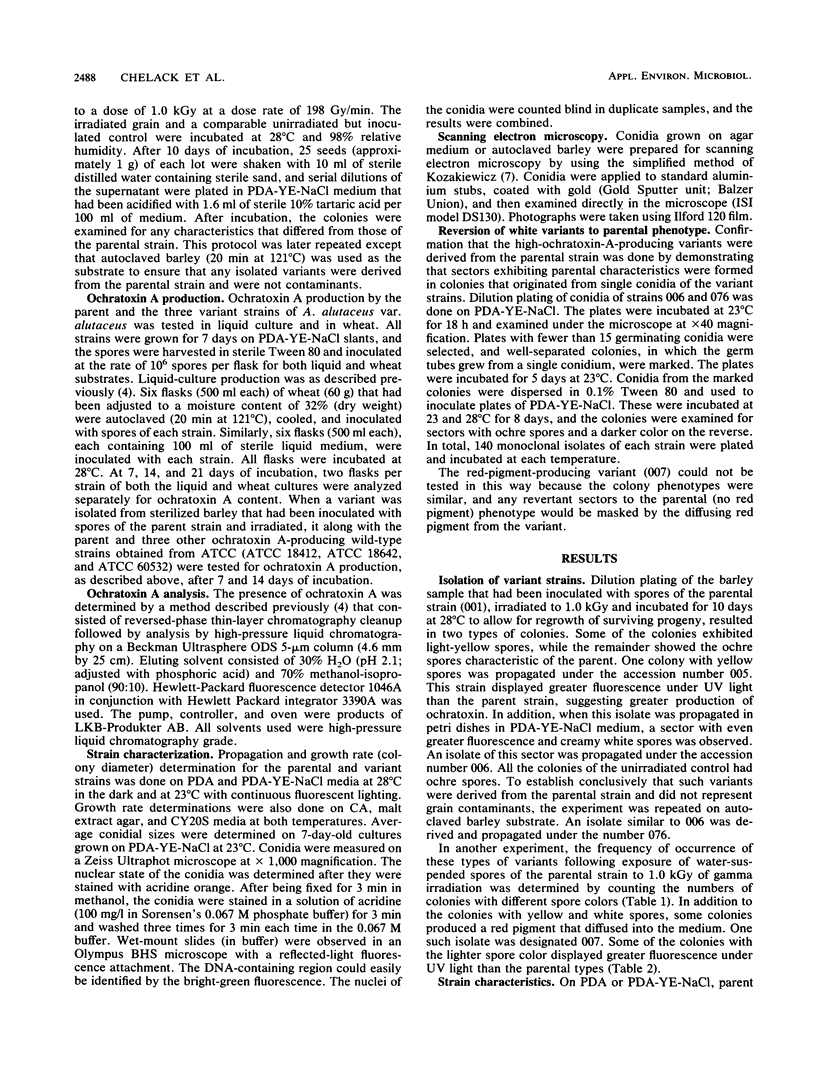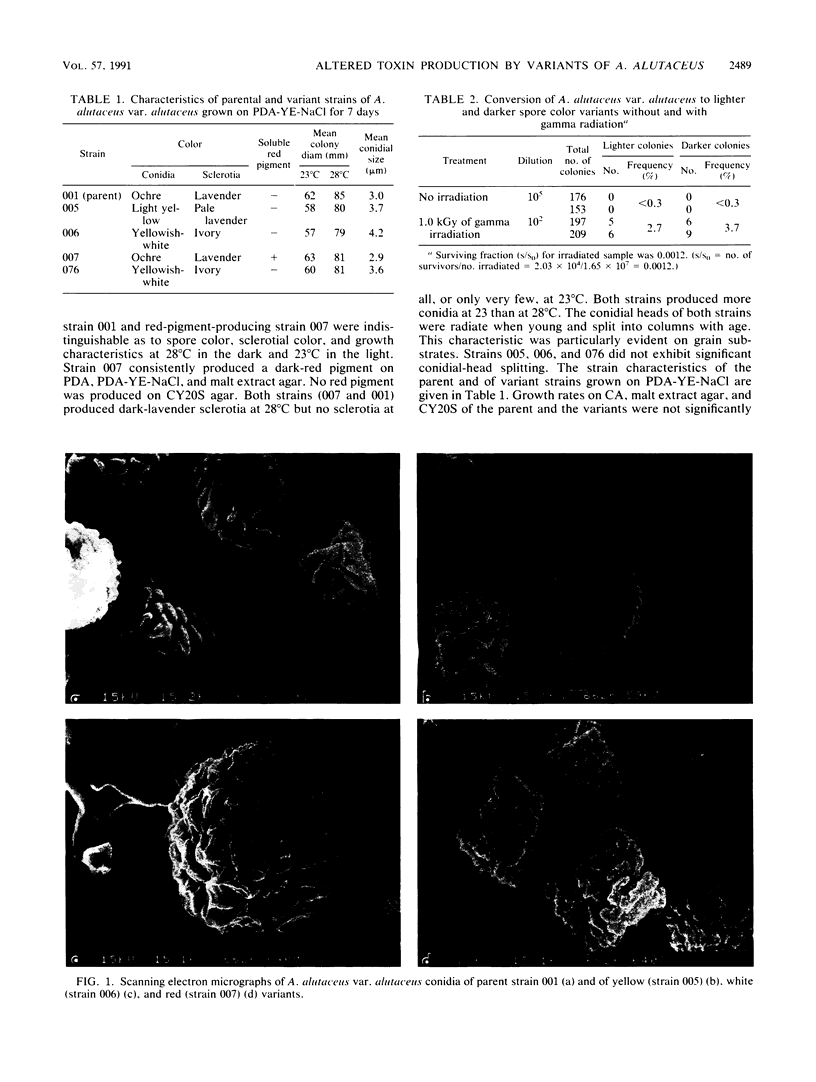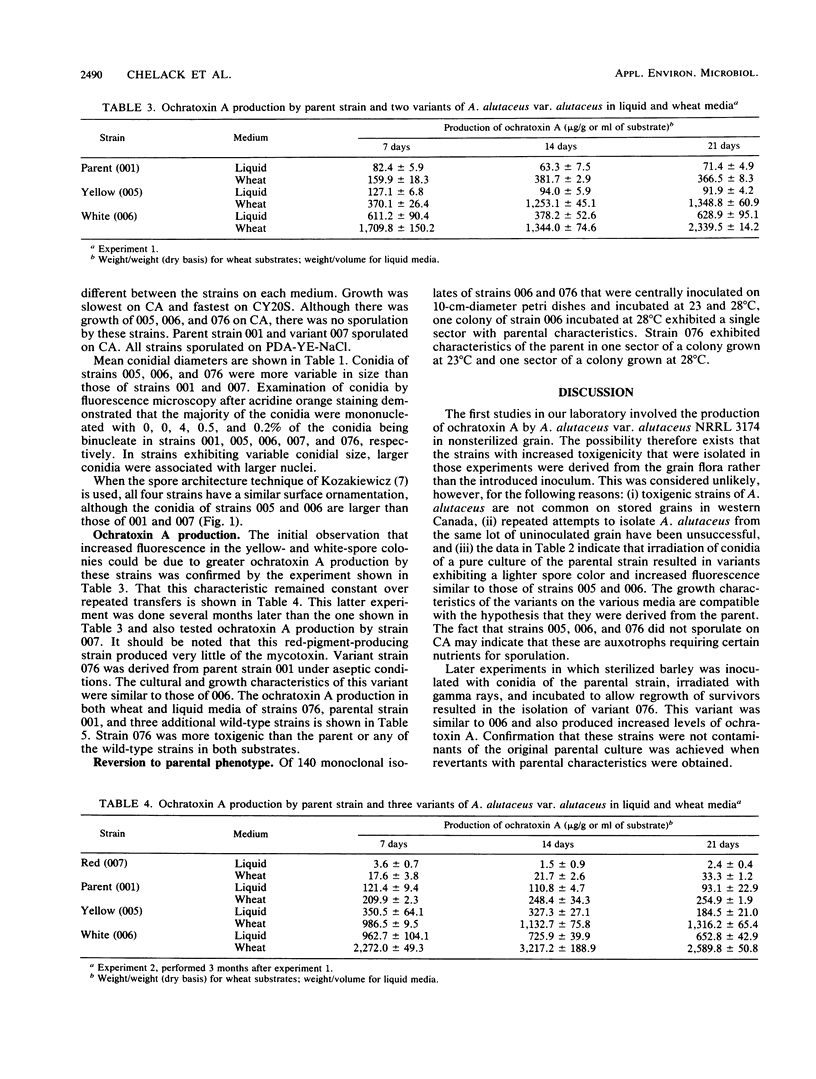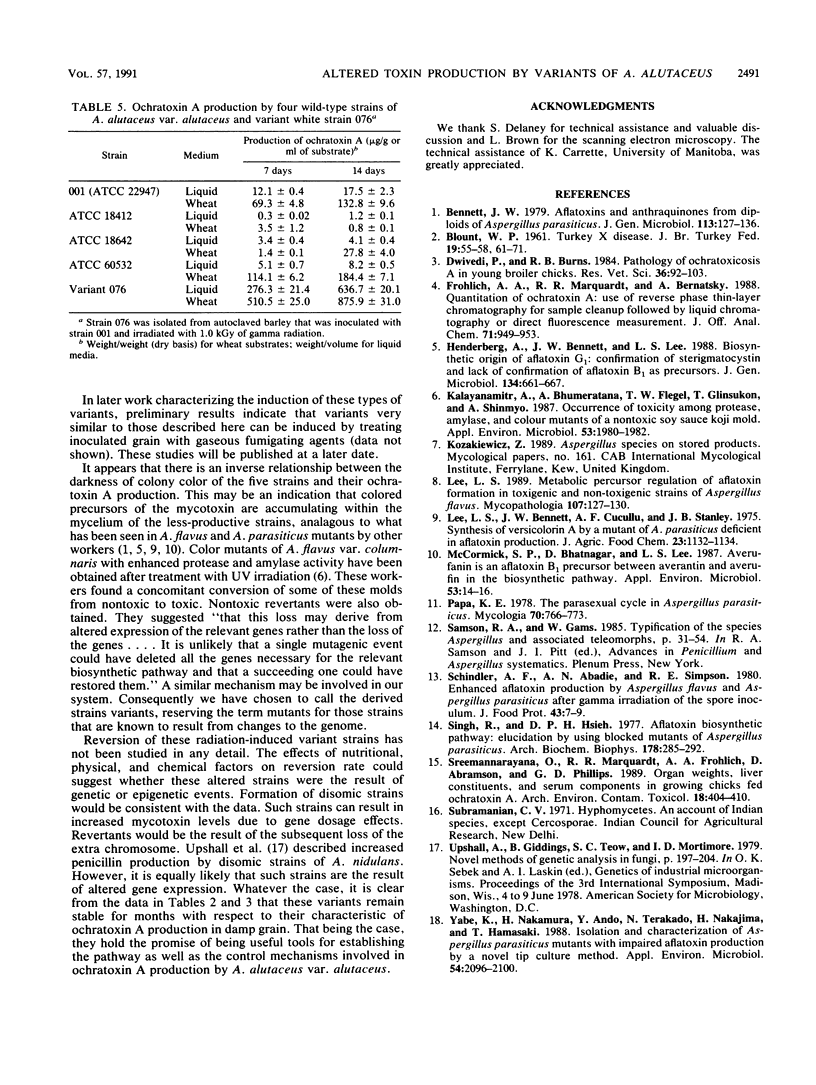Abstract
The present studies, using Aspergillus alutaceus var. alutaceus Berkeley et Curtis (formerly A. ochraceus Wilhelm) NRRL 3174 along with three other wild-type strains, were undertaken in an attempt to understand the effects of irradiation and other treatments on mycotoxin production in grain. Bedford barley was inoculated with spores of NRRL 3174, gamma irradiated, and incubated at 28 degrees C and 25% moisture. After 10 days of incubation, two colony types, ochre (parental) and yellow (variant), were isolated from the grain. Further culturing of the yellow variant resulted in the spontaneous appearance of a white variant that exhibited greatly enhanced fluorescence under UV light. In subsequent work, we have also isolated variants producing a soluble red pigment. In addition, in model experiments involving irradiation (1 kGy) of pure cultures, induction frequencies ranging between 2 and 4% (survival basis) were observed for the yellow and red variants. Inoculation of these variants into wheat and incubation for 14 days at 28 degrees C and 32% moisture resulted in ochratoxin A production in the relative amounts of 0.09:1:4.6:9.3 for the red, ochre (parental), yellow, and white variants, respectively. Additional characteristics of these isolates are described. Confirmation that the white high-ochratoxin-A-producing variants were derived from the parental strain was demonstrated by obtaining revertant sectors in monoclonal cultures of the variants.
Full text
PDF




Images in this article
Selected References
These references are in PubMed. This may not be the complete list of references from this article.
- Bennett J. W. Aflatoxins and anthraquinones from diploids of Aspergillus parasiticus. J Gen Microbiol. 1979 Jul;113(1):127–136. doi: 10.1099/00221287-113-1-127. [DOI] [PubMed] [Google Scholar]
- Dwivedi P., Burns R. B. Pathology of ochratoxicosis A in young broiler chicks. Res Vet Sci. 1984 Jan;36(1):92–103. [PubMed] [Google Scholar]
- Frohlich A. A., Marquardt R. R., Bernatsky A. Quantitation of ochratoxin A: use of reverse phase thin-layer chromatography for sample cleanup followed by liquid chromatography or direct fluorescence measurement. J Assoc Off Anal Chem. 1988 Sep-Oct;71(5):949–953. [PubMed] [Google Scholar]
- Henderberg A., Bennett J. W., Lee L. S. Biosynthetic origin of aflatoxin G1: confirmation of sterigmatocystin and lack of confirmation of aflatoxin B1 as precursors. J Gen Microbiol. 1988 Mar;134(3):661–667. doi: 10.1099/00221287-134-3-661. [DOI] [PubMed] [Google Scholar]
- Kalayanamitr A., Bhumiratana A., Flegel T. W., Glinsukon T., Shinmyo A. Occurrence of toxicity among protease, amylase, and color mutants of a nontoxic soy sauce koji mold. Appl Environ Microbiol. 1987 Aug;53(8):1980–1982. doi: 10.1128/aem.53.8.1980-1982.1987. [DOI] [PMC free article] [PubMed] [Google Scholar]
- Lee L. S., Bennett J. W., Cucullu A. F., Stanley J. B. Synthesis of versicolorin A by a mutant strain of Aspergillus parasiticus deficient in aflatoxin production. J Agric Food Chem. 1975 Nov-Dec;23(6):1132–1134. doi: 10.1021/jf60202a011. [DOI] [PubMed] [Google Scholar]
- Lee L. S. Metabolic precursor regulation of aflatoxin formation in toxigenic and non-toxigenic strains of Aspergillus flavus. Mycopathologia. 1989 Sep;107(2-3):127–130. doi: 10.1007/BF00707549. [DOI] [PubMed] [Google Scholar]
- McCormick S. P., Bhatnagar D., Lee L. S. Averufanin is an aflatoxin B1 precursor between averantin and averufin in the biosynthetic pathway. Appl Environ Microbiol. 1987 Jan;53(1):14–16. doi: 10.1128/aem.53.1.14-16.1987. [DOI] [PMC free article] [PubMed] [Google Scholar]
- Papa K. E. The parasexual cycle in Aspergillus parasiticus. Mycologia. 1978 Jul-Aug;70(4):766–773. [PubMed] [Google Scholar]
- Singh R., Hsieh D. P. Aflatoxin biosynthetic pathway: elucidation by using blocked mutants of Aspergillus parasiticus. Arch Biochem Biophys. 1977 Jan 15;178(1):285–292. doi: 10.1016/0003-9861(77)90193-x. [DOI] [PubMed] [Google Scholar]
- Sreemannarayana O., Marquardt R. R., Frohlich A. A., Abramson D., Phillips G. D. Organ weights, liver constituents, and serum components in growing chicks fed ochratoxin A. Arch Environ Contam Toxicol. 1989 May-Jun;18(3):404–410. doi: 10.1007/BF01062365. [DOI] [PubMed] [Google Scholar]
- Yabe K., Nakamura H., Ando Y., Terakado N., Nakajima H., Hamasaki T. Isolation and characterization of Aspergillus parasiticus mutants with impaired aflatoxin production by a novel tip culture method. Appl Environ Microbiol. 1988 Aug;54(8):2096–2100. doi: 10.1128/aem.54.8.2096-2100.1988. [DOI] [PMC free article] [PubMed] [Google Scholar]



